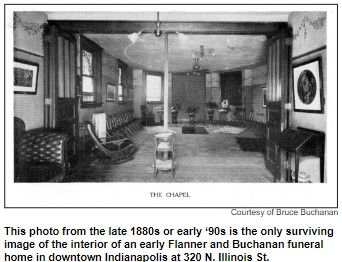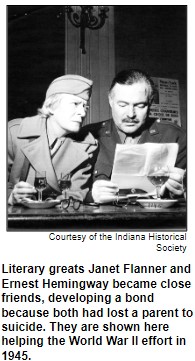Hoosier History Live is an independently produced new media project about Indiana history, integrating podcasts, website www.HoosierHistoryLive.org, weekly enewsletter, and social media. Its original content comes initially from a live with call in weekly talk radio show hosted by author and historian Nelson Price. You can hear the show live Saturdays from noon to 1 pm ET at WICR 88.7 fm or stream the show live at the WICR HD1 app on your phone, or at our website.
July 20, 2024
A famous fashion designer, a Nobel Peace Prize nominee and more: the Levinsons of Noblesville


 There's a connection between the city of Noblesville and glamorous Hollywood celebrities such as Lauren Bacall and Marilyn Monroe.
There's a connection between the city of Noblesville and glamorous Hollywood celebrities such as Lauren Bacall and Marilyn Monroe.
Also, there once was a potential link between Noblesville, the county seat of Hamilton County, and the Nobel Peace Prize. In addition, a popular Indiana chain of men's clothing stores during the mid and late 1900s had its beginnings with a shop in Noblesville.
All of the connections involved the Levinson family, which included Norman Norell, an internationally famous fashion designer from the 1940s through the early 1970s. His birth name in 1900 was Norman Levinson, but he eventually chose the name "Norell", explaining his selection this way: "Nor for Norman. L for Levinson. Another L for looks." Norell designed clothes worn by many of the world's most recognizable women including Bacall, Monroe and Gloria Swanson. When he died in 1972, the front-page headline in the New York Times proclaimed Norell: "Made Seventh Avenue the Rival of Paris".
His uncle, Salmon Levinson (1865-1941), was an anti war crusader who was nominated for the Nobel Peace Prize. A philanthropist and a successful attorney, Salmon Levinson helped Carl Sandburg get his start in poetry.
Norell's father and brother ran what became known for generations as Harry Levinson's Men's Shops; a retailer of suits, sports jackets and other quality menswear. It expanded from a flagship store in downtown Indianapolis to outlets in Bloomington, Evansville and other cities.
 Nelson will be joined in studio by Hamilton County historian David Heighway, who will share insights about the multi-generational impact of the Levinson family. They settled in Noblesville in the 1850s when, as David has written, "they were one of the few Jewish families" in the town. David is the author of Hidden History of Hamilton County, Indiana, which includes a chapter about the Levinsons. During our show, he also will share insights about the new Crossroads Discovery Center, a genealogy and history resource at the Hamilton East Public Library, where David is based.
Nelson will be joined in studio by Hamilton County historian David Heighway, who will share insights about the multi-generational impact of the Levinson family. They settled in Noblesville in the 1850s when, as David has written, "they were one of the few Jewish families" in the town. David is the author of Hidden History of Hamilton County, Indiana, which includes a chapter about the Levinsons. During our show, he also will share insights about the new Crossroads Discovery Center, a genealogy and history resource at the Hamilton East Public Library, where David is based.
In 2021, an Indiana State Historic Marker was erected in Noblesville near the birthplace of Norman Norell, who designed clothes for both Hollywood and Broadway productions, including outfits worn by Doris Day in That Touch of Mink (1962). He designed high fashion clothes for the general public that were carried in more than 100 stores across the country, including the L.S. Ayres chain in Indiana. Norell mentored another famous fashion designer from Indiana: Fort Wayne native Bill Blass.
Norell's uncle, Salmon Levinson, was nominated for a Nobel Peace Prize in 1929 after writing a document that proposed outlawing war. His philanthropic endeavors included establishing awards at Noblesville High School and at a poetry magazine. The first winner of the poetry award was Carl Sandburg, who went on to a distinguished career as a poet and historian.
Hamilton County historian David Hamilton has been a Hoosier History Live guest several times, including on a show in 2021 that explored myths about the town of Strawtown and a show in 2017 about the violent early era of Fishers.
Latest Podcast Available!
Latest Podcast Available!

For a complete list of show podcasts and show enewsletters, please go to ARCHIVES on our website.
A Word from Molly and Nelson
Hoosier History Live to significantly reduce its media offering
"Yes, folks and fans, we know you love Hoosier History Live. But our resources have been dwindling for a long time. We just can't keep running on nothing!
In August, you will still be able to hear Nelson doing a live with call-in talk show Saturdays at noon on WICR 88.7 fm, or stream it on the WICR HD1 app. And we will continue to keep our website up so that our years worth of podcasts will be available for listening.
IF you are interested in raising money for Hoosier History Live, contact nelson@hoosierhistorylive.org. Yes, it is mostly about the money, and we just can't keep doing it on nothing!
Sincerely, Molly and Nelson




 Ever since the 1820s, when David Buchanan arrived by covered wagon in the Indianapolis area and opened a tavern before becoming a farmer, the Flanner and Buchanan families have been intertwined with city history.
Ever since the 1820s, when David Buchanan arrived by covered wagon in the Indianapolis area and opened a tavern before becoming a farmer, the Flanner and Buchanan families have been intertwined with city history.  All of that and more will be explored during our show when
All of that and more will be explored during our show when  By then, Flanner and Buchanan had opened Fall Creek Mortuary, a structure that was built as a funeral center during an era when that was unusual; most were located in converted houses. Fall Creek Mortuary, which had a built-in organ and served as the flagship of the Flanner and Buchanan operation for decades, eventually was demolished in the 1990s.According to Building Community, the word "undertaker" was coined in the 19th century to describe someone, typically a carpenter, who was willing to "undertake the unpleasant duty" of handling the final presentations of the deceased. By 1887, when Frank Flanner persuaded his brother-in-law Charles Buchanan, Anna's husband, to join him in the business, the term undertaker was being dropped in favor of the more professional term of "funeral director". Like the Flanners, Charles Buchanan became immersed in civic affairs, including crusading for the creation of the
By then, Flanner and Buchanan had opened Fall Creek Mortuary, a structure that was built as a funeral center during an era when that was unusual; most were located in converted houses. Fall Creek Mortuary, which had a built-in organ and served as the flagship of the Flanner and Buchanan operation for decades, eventually was demolished in the 1990s.According to Building Community, the word "undertaker" was coined in the 19th century to describe someone, typically a carpenter, who was willing to "undertake the unpleasant duty" of handling the final presentations of the deceased. By 1887, when Frank Flanner persuaded his brother-in-law Charles Buchanan, Anna's husband, to join him in the business, the term undertaker was being dropped in favor of the more professional term of "funeral director". Like the Flanners, Charles Buchanan became immersed in civic affairs, including crusading for the creation of the  Janet Flanner, Frank Flanner's daughter, became one of the first movie critics in the country, writing about silent films for the Indianapolis Star. Beginning in the 1920s, though, she was a correspondent for The New Yorker magazine based in Paris. That's where she befriended other American expatriates including legendary novelists Ernest Hemingway and F. Scott Fitzgerald.
Janet Flanner, Frank Flanner's daughter, became one of the first movie critics in the country, writing about silent films for the Indianapolis Star. Beginning in the 1920s, though, she was a correspondent for The New Yorker magazine based in Paris. That's where she befriended other American expatriates including legendary novelists Ernest Hemingway and F. Scott Fitzgerald.
